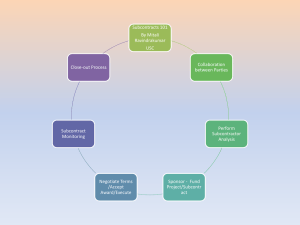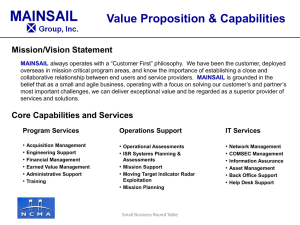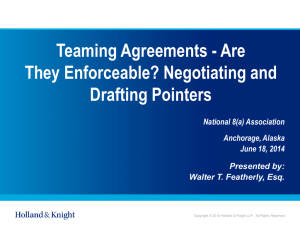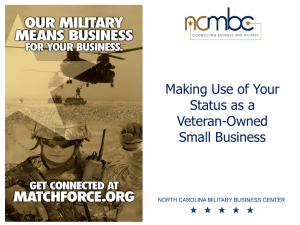Teaming_Arrangements_SDV_2010
advertisement
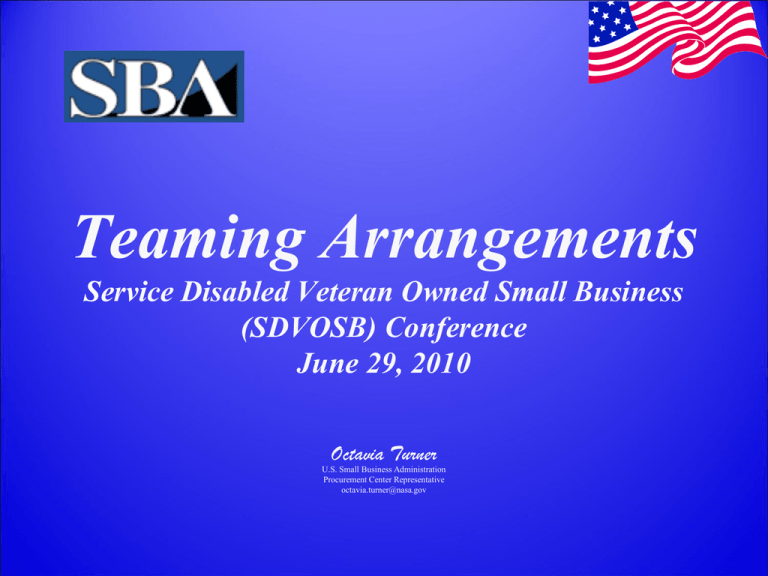
Teaming Arrangements Service Disabled Veteran Owned Small Business (SDVOSB) Conference June 29, 2010 Octavia Turner U.S. Small Business Administration Procurement Center Representative octavia.turner@nasa.gov How Important Are Small Businesses? In 2008, there were 29.6 million businesses in the United States, according to Office of Advocacy estimates - Represent 99.7 percent of all employer firms Employ just over half of all private sector employees Pay 44 percent of total U.S. private payroll Have generated 64 percent of net new jobs over the past 15 years Hire 40 percent of high tech workers (such as scientists, engineers, and computer workers) Produce 13 times more patents per employee than large patenting firms; these patents are twice as likely as large firm patents to be among the one percent most cited What is SBA’s definition of a SB? • Independently owned and operated • Not dominant in its field of operations • Depending on the industry, size standard eligibility is based on: the average number of employees for the preceding 12-months -or average annual receipts for a three-year period. What is a Service Disabled Veteran Owned Small Business? • The SDV must have a service-connected disability that has been determined by the Dept of Veterans Affairs or DOD • The SDVO SBC must be small under the NAICS code assigned to the procurement • The SDV must unconditionally own 51% of the SDVO SBC • The SDV must control the management and daily operations of the SDVO SBC • The SDV must hold the highest officer position in the SDVO SBC What are the types of SDVOSB procurements? Competitive Sole Source •Rule of Two • Only 1 Source • Up to $5.5 M •Buys over $3000 •No upward $ limit •Award can be made at fair market price (mfg) • Up to $3 M (non-mfg) • Award can be made at fair market price Can simplified acquisition procurements be set-aside? If a requirement is at or below the simplified acquisition threshold, a Contracting Officer may set-aside the requirement for competition among SDVOSBs using simplified acquisition procedures or may award a sole source contract to a SDVOSBs. What requirements are not available for SDVOSB set-aside? Federal Prison Industries (FPI) Ability One Program (formerly JWOD) Current SBA 8(a) Business Development Program requirements Orders under indefinite delivery contracts Orders against federal supply schedules What are some examples of team arrangements? • • • • • Joint Venture (JV) Prime/Subcontractor Relationship Limited Liability Corporation (LLC) Mentor-Protégé Agreement Partnership What’s a teaming arrangement? FAR 9.601 Contractor team arrangement,” as used in this subpart, means an arrangement in which— • Two or more companies form a partnership or joint venture to act as a potential prime contractor • A potential prime contractor agrees with one or more other companies to have them act as its subcontractors under a specified Government contract or acquisition program. Does the government recognize teaming arrangement? FAR 9.603 The government will recognize the integrity and validity of contractor team arrangements, provided, the arrangements are identified and company relationships are fully disclosed in an offer or, for arrangements entered into after submission of an offer, before the arrangement becomes effective. What are the advantages of teaming? • • • • • • • • • Increase annual profits Complement each other’s unique capabilities Minimize risks Gain first hand experience Increase competitiveness Compete with large firms Compete for larger more technically complex contracts Expand geographically What are common reasons for not teaming? • Do not want to give up control • Prefer a direct relationship with the federal government • Lack of trust that the team will be profitable • Takes time and effort to build the right relationship Joint Venture - an association of persons or concerns …consorting to engage in and carry out no more than three specific or limited-purpose business ventures for joint profit over a two year period, for which purpose they combine their efforts, property, money, skill, or knowledge, but not on a continuing or permanent basis for conducting business generally... joint venture entity cannot submit more than three offers over a two year period, starting from the date of the submission of the first offer…” (13 CFR 121.103(h) and Federal Acquisition Regulation 19.101) A Joint Venture is when two or more firms organize as one to perform and/or provide a product or service. SDVOSB Joint Venture - A joint venture of at least one SDVO SBC and one or more other business concerns may submit an offer as a small business for a competitive SDVO SBC procurement so long as each concern is small under the size standard corresponding to the NAICS code assigned to the contract… How do you determine the size of a Joint Venture? Joint Venture = Affiliation • The members of a JV or team are considered to be • • • affiliated for size purposes The size of each team member contributes to the total size of the JV or team The JV or team is small only if the combined annual receipts or employees of all the firms in the JV meet the size standard for the procurement It does not matter whether control is exercised, so long as the power to control exists. Can you form a Joint Venture and not be affiliated for size purposes? Exclusions from affiliation - A JV of two or more business concerns may submit an offer as a small business for a federal procurement without regard to affiliation provided: What are exclusions to affiliation? Each concern is small under the size standard corresponding to the NAICS code assigned to the contract when: (a) The procurement qualifies as a “bundled” requirement, at any dollar value; or What are exclusions to affiliation? (cont’d) (b) Other than a “bundled” requirement and: (1) For a procurement having a revenuebased size standard, the dollar value or the procurement, including options, exceeds half the size standard corresponding to the NAICS code assigned to the contract; or (2) For a procurement having an employee-based size standard, the dollar value of the procurement, including options, exceeds $10 million. Is this JV considered a small business entity? Small Business Set-Aside Size Standard for NAICS 237990 is $33.5M $20M estimated value of contract award Joint Venture Team: 1. SDVOSB – average annual receipts of $3M with 100 employee 2. Small Business – average annual receipts of $18M with 400 employees 3. 8(a) – average annual receipts of $11M with 250 employees Can this JV bid on a small business set-aside? YES! This JV team can bid on this service disabled veteran owned small business set-aside and still be considered small since the dollar value of the procurement ($20M) exceeds half the size standard (half of $33.5M) and each team member is small for the applicable NAICS code. Is this JV considered a small business entity? Small Business Set-Aside – Size Standard for NAICS 541330 is $4.5M $20M estimated value of contract award Joint Venture Team: 1. SDVOSB – average annual receipts of $3M with 100 employee 2. Small Business – average annual receipts of $18M with 400 employees 3. 8(a) – average annual receipts of $11M with 250 employees Can this JV bid on a small business set-aside? NO! This JV team cannot bid on service disabled veteran owned small business set-aside and still be considered small. Two team members are large for the applicable NAICS code. Is this JV considered a small business entity? Small Business Set-Aside – Size Standard for NAICS 541712 is 500 employees $8M estimated value of contract award Joint Venture Team: 1. SDVOSB – average annual receipts of $3M with 100 employee 2. Small Business – average annual receipts of $18M with 400 employees 3. 8(a) – average annual receipts of $11M with 250 employees Can this JV bid on a small business set-aside? NO! This JV team cannot bid on this service disabled veteran owned small business set-aside and still be considered small. The size standard for the applicable NAICS code is based on the number of employees. The procurement does not exceed $10M. What is the performance of work requirement? Services 50% of personnel costs on own employees or other SDVOSB(s) employees Supplies 50% of manufacturing cost, excluding materials, on own employees or employees of other SDVOSB(s) General Construction Special Trade Construction 15% of cost of contract with 25% of cost of contract, own employees or employees of excluding materials, with own other SDVOSB(s) employees or employees of other SDVOSB(s) NOTE: Does not apply to unrestricted procurements! How does the performance of work requirement affect the SDVOSB JV? SDVOSB Set-Aside for services: • Small Business A: can only do 25% of job with his • • • own people Small Business B: can only do 25% of job with his own people Neither A nor B can bid the job alone. However, if they form a Joint Venture, they can combine their efforts, doing 50% with their own people, and can bid the job. What are the contents of a JV agreement? SDVOSB JV agreement must: • • • • • • Set forth purpose of JV Designate SDVOSB as managing venturer and an employee of managing venturer as project manager State that at least 51% of the net profits earned by the JV go the SDVOSB venturer(s) Specify the responsibilities of the parties with regard to contract performance, source of labor and negotiation of the SDVOSB contract Obligate all parties to the joint venture to ensure performance of the SDVOSB contract and to complete performance despite the withdrawal of any member Require the final original records be retained by the managing venturer upon completion of the SDVOSB contract performed by the joint venture (13 CFR 125.15(b)(2) Please Note! If Contractor A and B form a joint venture— •Together they act as the prime contractor under a Federal contract •The JV has its own DUNS number and CAGE code •The JV is registered in CCR and ORCA as a separate entity •The JV may have subcontractors. Please Note! • The performance of work requirements apply to the cooperative effort of the joint venture partners, not its individual members. • Contract is executed in joint venture’s name • A large business cannot be a JV participant on a SDVOSB set-aside -- One exception: 8(a) Mentor-Protégé Please Note! • The JV is responsible for performance • JV members have privity of contract with the government • Members share profits and risk of loss • JV members are individually and equally liable for contract performance What is a prime/subcontract team arrangement? FAR 9.601 “Contractor team arrangement,” as used in this subpart, means an arrangement in which— A potential prime contractor agrees with one or more other companies to have them act as its subcontractors under a specified Government contract or acquisition program. What are the responsibilities of the prime contractor? Prime Contractor: • Agrees to furnish supplies or services and • • • • government agrees to pay Responsible for adhering to terms and conditions of contract Manages and controls the contract Government has privity of contract only with the prime contractor Relationships identified before offer is submitted What are the responsibilities of the subcontractor? Subcontractor: • Agrees to furnish supplies or services and prime • • • • contractor agrees to pay Responsible for adhering to terms and conditions of subcontract Conveys terms and conditions to second-tier subcontractors Subcontractor has privity of contract only with the prime contractor Relationships can be defined before or after award What is an ostensible subcontractor? 13 CFR 121.103(h)(4) A contractor and its ostensible subcontractor are treated as joint venturers, and therefore affiliates, for size determination purposes. An ostensible subcontractor is a subcontractor that performs primary and vital requirements of a contract, or of an order under a multiple award schedule contract, or a subcontractor upon which the prime contractor is unusually reliant… What does SBA consider in the ostensible subcontractor determination? All aspects of the prime/sub relationship are considered: • • • • • • • Joint banking account with joint signatures Joint approval on invoices Joint authority required for most actions Unusual reliance upon teaming Agreements between the prime and subcontractor (such as bonding assistance or the teaming agreement) Whether the subcontractor is the incumbent contractor and is ineligible to submit a proposal because it exceeds the applicable size standard for the solicitation Subcontractor manages contract or subcontractor employees are key personnel Teaming Tips Selecting Teaming Partners – consider: • capabilities, financial, credit history, other resources • past performance • debarment/suspension • management styles, corporate cultures, strategic visions • past and current teaming history Successful Teaming Qualities • compatible contractors • good teaming agreements in place What research can be performed prior to deciding to team? • Attend industry days, outreach events, match making events, conferences, etc. • Network with prospective prime contractors • Watch for full and open solicitations with evaluation criteria that encourages teaming • Check the FBO “interested parties” list for potential partners • Ask for procurement history to identify previous contracts • Service Corps of Retired Executives (SCORE) article: “Teaming to Help Win Government Contracts” http://www.score.org/pdf/OPEN%20Govt%20Team%20to %20Win%203-1.pdf What are characteristics of a good teaming arrangement? •Tasks are clearly divided among team members •Responsibilities are clearly defined •Team members cannot be easily replaced •Team members will not team with competitors on the same procurement •All parties benefit from the relationship •Clearly define roles of prime contractor and subcontractor when contract is awarded Wrap Up Joint Venture • • • • Entered into prior to award Contract written in joint venture name Temporary arrangement – 3 offers in two year period Considered as new entity for federal contracting purposes • Team members are affiliated Prime/Subcontractor • Entered into before or after award • Prime is responsible for completing the contract • Prime/subcontract relationship established for a specific contract Where can I find teaming opportunities? 1. Federal Business Opportunity – http://www.fbo.gov 2. SUBNet – http://web.sba.gov/subnet 3. Dynamic Small Business Search – http://www.ccr.gov 4. Prime Contractor List – http://www.sba.gov/gc 5. Networking – conferences, workshops, training sessions References 1. Code of Federal Regulations http://ecfr.gpoaccess.gov/ 13 CFR 121 – SBA Size Regulation 13 CFR 124.513 -- SBA 8(a) Joint Venture Rules 13 CFR 124.520 -- SBA Mentor Protégé 13 CFR 125 Subpart C -- Contracting with SDVO SBCs 13 CFR 126.616 – HUBZone Joint Ventures 2. Federal Acquisition Regulation NAICS http://farsite.hill.af.mil 3. DoD Handbook for Facilitating Small Business Teaming Arrangements http://www.acq.osd.mil/osbp/resources/teaming.pdf Who Needs DSBS? • All small firms seeking federal, state, and private contracts • All federal and state government agencies • All major prime contractors Veterans in Business Still Serving America 44

